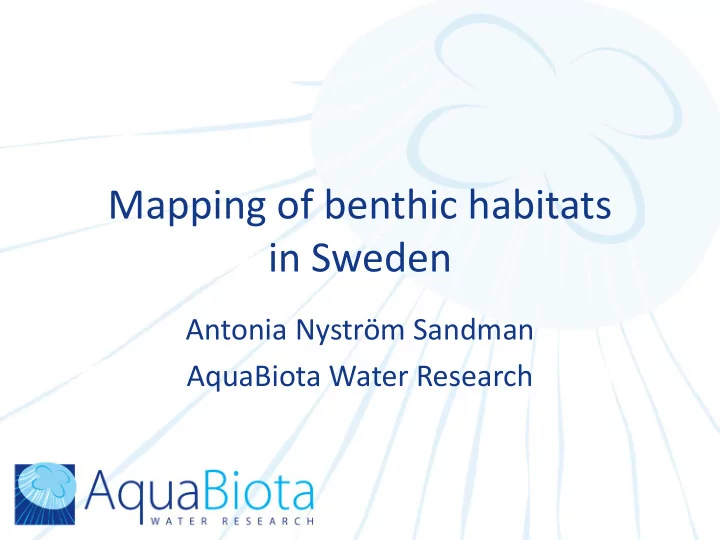

Mapping of benthic habitats in Sweden Antonia Nyström Sandman AquaBiota Water Research
Marine biotope monitoring and mapping in Sweden Mona Naeslund Swedish Species Information Centre (ArtDatabanken, ADb), SLU Mona.naeslund@slu.se
Sweden – who does what in biological monitoring and mapping? • SwAM: Sw edish A gency for M arine and Water Management. (https://www.havochvatten.se/en/start.html , Norbert Häubner <norbert.haubner@havochvatten.se>). • County administrative boards- 14 coastal counties, protected areas (http://www.lansstyrelsen.se/Sv/Pages/default.aspx) • Geological survey of Sweden (SGU) bottom sediment. (http://www.sgu.se/en/) • Swedish Maritime Administration (SMA) Hydrography (http://www.sjofartsverket.se/en/) • Swedish Agricultural University (SLU)- Advisory for fish (SLU aqua) & EU nature directives, commissions, redlists, species, habitats (ArtDatabanken ) (http://www.slu.se/en/) • Consultants: AquaBiota Water Research AB and others.- field work, models of biotopes, plans for biotope mapping 2016-2021 (http://www.aquabiota.se/en/) Mona Naeslund, ArtDatabanken Swedish Species Information Centre
Methods used in SE: large scale Coastal, homogenous biotopes, large areas: remote sensing Zostera marina Ruppia • cirrhosa Satellite (spot 5) data: Eelgrass & other large green vegetation, Cerastoderma Arenicola sp marina • Aerial photographs (colour orthophoto): Habitats directive Photos: Anders Olsson 1140 mudflats & sandflats, Hard bottoms Soft s. with veg. Soft sediment • LIDAR: Airborne laser scanning: (Bothnian bay, Baltic proper)
Methods used in SE: small scale Complex areas, spp: spatial modelling Interpolation: background data for spatial modelling, evenly dispersed point data are made into continuous maps: ex. depth, Spatial modelling: continuous maps. Predictors of ex. depth, slope, secchi depth, wave exposure, substrate for a biotope/species. Mona Naeslund, ArtDatabanken Swedish Species Information Centre
Benthic Monitoring SE- soft bottoms Soft bottom fauna - Indicator: eutrophication, O 2 - Fauna - Sediment (grain size, water, color, mm) - Oxygen (SS-EN 25813) - Kattegatt, Skagerrak sediment profile camera (blue dots picture right.) - Method: HELCOM 1988 - Linc to methods: https://www.havochvatten.se/hav/samordning-- fakta/miljoovervakning/miljoovervakningens-programomrade-kust-och- hav/delprogram-makrofauna-mjukbotten.html *HELCOM 1988. Guidelines for the Baltic Monitoring Programme for the third stage. Biological Determinands. BSEP No 27D, 91-100. Mona Naeslund, ArtDatabanken Swedish Species Information Centre
Monitoring SE- Vegetation Hard & soft bottoms • Diving depth profiles (10-20 m depth) • Indicator: eutrophication (also pollution, climate change, salinity change) • Method: Naturvårdsverket 2004* • Linc to method: • https://www.havochvatten.se/hav/vagledning--lagar/vagledningar/ovriga- vagledningar/miljoovervakningens-metoder-och-undersokningstyper- inom-programomrade-kust-och-hav.html * Naturvårdsverket 2004. Vegetationsklädda bottnar, ostkust. Mona Naeslund, ArtDatabanken Swedish Species Information Centre
Monitoring SE- new methods • Drop- video , (also diving & Aquascope) Havs- och vattenmyndigheten (manus) 1 , (in estuaries (1130), lagoons (1150), Large shallow inlets and bays (1160), reefs (1170), Baltic esker islands (1610), Boreal Baltic islets and small islands (1620), Boreal Baltic narrow inlets (1650)) • Infauna , sediment core (10 cm) in Mudflats and sandflats (1140), method: Havs- och vattenmyndigheten (manus) 2 • Fish fry, juvenles & vegetation . Small detonations & diving. Havs- och vattenmyndigheten (manus) 3 • Remote sensing: dredging, dumping, buildings, bottom trawling, method: Havs- och vattenmyndigheten (manus) 4 1 . Havs- och vattenmyndigheten (manus) Undersökningstyp: Visuella undervattensmetoder för uppföljning av marina naturtyper och typiska arter. 2. Havs- och vattenmyndigheten (manus) Undersökningstyp: Uppföljning av 1140 blottade ler- och sandbottnar. 3. Havs- och vattenmyndigheten (manus) Undersökningstyp: Yngelprovfiske med små undervattensdetonationer. 4. Havs- och vattenmyndigheten (manus) Undersökningstyp: Uppföljning av påverkan på marina bentiska samhällen med indirekta metoder
Monitoring programs Under revision (or soon-to-be): • Benthic fauna (under revision) • Plankton (in prep) • Fish (in prep) • Vegetation (coming up)
Why mapping?- demands & challenges Challenges: varied coastline, substrate (mixed), depth, time Map from HELCOM data & National MSFD map service. BALANCE- Environmental substrate, salinity. objectives, Aichi protected areas Habitats directive 10% by 2020 Green Marine spatial infrastructure planning OSPAR HELCOM redlist biotopes HELCOM HUB Mona Naeslund, ArtDatabanken Swedish Species Information Centre
Preliminary mapping plans • Marine spatial planning scale – Ready by 2017 – 100-200 m resolution • County scale – Ready by 2021 – 10(-25) m resolution
Preliminary mapping plans
Preliminary mapping plans Dominating and/or important benthic biota HUB (level 5 or 6)/EUNIS biotopes OSPAR priority habitats (west coast) Natura2000 habitats Recruitment areas for fish Conservation values Green infrastructure
Indicators OSPAR HELCOM National Distribution, pattern and extent of benthic biotopes (pre-core) BH-3 Physical damage of predominant and Cumulative impact on benthic biotopes (pre- special habitats (candidate) core) BH-4 Area of habitat loss (candidate) BH-1 Typical species composition (core) BH-2 Multi-metric indices (core) State of the soft-bottom macrofauna BQI for coastal waters (1.6B; 5.3E; 6.2A) communities (core) BH-2 Multi-metric indices (core) State of the soft-bottom macrofauna BQI for offshore waters (1.6D; 5.3F; 6.2B) communities (core) BH-5 Size-frequency distribution of bivalve or Population structure of long-lived other sensitive/indicator species (candidate) macrozoobenthic species (core) Lower depth limit distribution of the Depth distribution of macro vegetation in macrophyte community (pre-core) coastal waters (1.5A; 5.3A) Biomass ratio of opportunistic and perennial macroalgae (candidate)
Recommend
More recommend